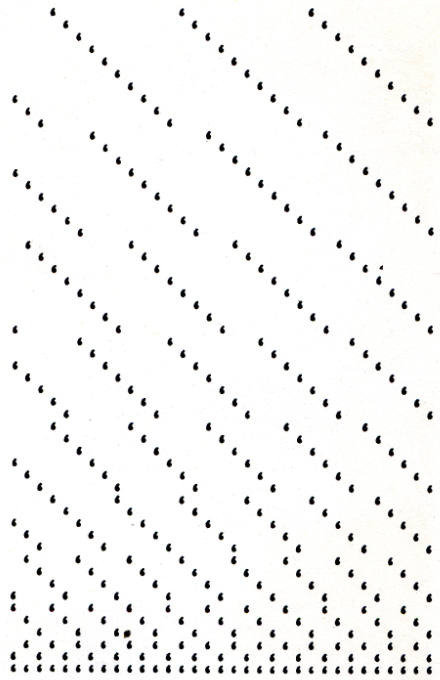9/1/2015
Two exhibitions
Chert, Berlin
"Home Archives" exhibits Paulo Bruscky and Robert Rehfeldt's Mail Art Exchanges from East Berlin to South America. In "Sign fiction" Ruth-Wolf Rehfeldt presents a wide selection of her 'postcard' pieces.

Home Archives
Paulo Bruscky, mail art from Robert Rehfeldt’s home archive
curated by Zanna Gilbert and David Horvitz
‘HOME ARCHIVES: Paulo Bruscky & Robert Rehfeldt’s Mail Art Exchanges from East
Berlin to South America’ is co-curated by Zanna Gilbert (postdoctoral fellow in the
Department of Drawings & Prints at MoMA, New York) and artist David Horvitz. This
exhibitionshows the private archives of the correspondence of Paulo Bruscky (Brazil,
1949) and Robert Rehfeldt (Germany, 1931–1993), bringing together their embellished
letters and art works sent over a period of around ten years, from 1975 onwards.
Throughout the 1970s, mail art connected hundreds of artists around the
world, creating a networked community of exchange, and in some cases,
political resistance. Chert is delighted to present an exhibition of
the correspondence of Paulo Bruscky (BR, 1949) and Robert Rehfeldt (DE,
1931–1993), bringing together their embellished letters and art works
sent over a period of around ten years, from 1975 onwards. These works
allow an in-depth look at how two artists who felt a strong affi
nity with
one another, but had never met, developed an enduring conversation and
friendship.
During the 1970s, Bruscky and Rehfeldt maintained an intimate dialogue
through their correspondence. While they met face-to-face only in
1982 when Bruscky travelled to Germany, the works they exchanged
were gestures of intimacy that shared their experiences and ideas,
rooted in their home cities of Recife and East Berlin. Although the
artists’ practices and viewpoints could be considered similar, Bruscky
was viewed as a communist in military-ruled Brazil, while Rehfeldt’s
artistic activities were deemed suspicious enough to be monitored by
the Stasi in the German Democratic Republic (GDR).
The artists’ correspondence frequently touched upon state surveillance
and issues of artistic liberty, including the arbitrary demands of
the ideology of the nation state on its citizens. Rehfeldt’s phrase
‘CONTART’, a contraction of the words ‘contact’ and ‘art’, was an
attempt to defy nationalist sentiments by uniting ‘art workers’ across
borders through the principle of contact. While both artists re
flected
on their given local contexts incessantly, they also sent works that
challenged, critiqued, and aimed to transcend the nation state.
Mail art creates personal archives that exist in artists’ homes around
the world. This exhibition shows not just two artists’ works, but two
private archives amassed by incidental custodians. The works exhibited
here are from these personal archives in two distinct places: it’s not
just about the work, but about where the work ends up. Rehfeldt’s
mailings to Bruscky currently sit in Bruscky’s studio in Recife, Brazil,
while Bruscky’s mailings to Rehfeldt are archived in a box in the home
of Ruth Wolf-Rehfeldt in Berlin.
These pieces will also be collected into a publication, which will
reconstruct the artists’ exchanges
––––
Ruth-Wolf Rehfeldt “Regenschauer” 1978, Typewriting
In the upper room Chert will present ‘SIGNS FICTION,’ a solo exhibition by Ruth-Wolf
Rehfeldt, Robert Rehfeldt’s wife. Historical works by the Berlin artist have been
selected and arranged to offer an overview of her production, focusing especially on
her involvement in the Mail Art movement. The table displays show a wide selection of
her “postcard” pieces, produced in mailablesize.
Ruth Wolf-Rehfeldt began to write poems, draw and make collages in the early
1970s.
Her first typewriter works, which she entitled “Typewritings” and whose
diversity defies description, were produced on an Erika typewriter. With
impressive precision, she arranged letters and punctuation marks into pictorial
elements, often creating a three-dimensional effect. The humour and finesse of
her work made Ruth Wolf-Rehfeldt a sought-after contact person in the network
of international artistic exchanges.
Born in 1932 in Wurzen, Saxony, she is one of the few women artists from the
former GDR to address in depth the relationship between text and image. Through
their involvement in the Mail Art network, she and her husband Robert Rehfeldt
were able to surmount the ban on exhibitions and publications by alternative
artists during the GDR period. Her artistic activity came to an end with the
unification of Germany in 1989.
Each of her works consists of an original - either an individual typed work or
a series - and of further reproductions in the form of carbon copies, postcards
or prints in formats ranging from A5 to A2. These works can just as easily be
situated within the context of conceptual art or visual and concrete poetry as
they can in the domain of Mail Art.
(Text extract from “Ruth-Wolf Rehfeldt, Original graphic works 1972-1989” the
first major exhibition of her poetic and visual “Typewritings”, The Stiftung
Neues Museum Weserburg, Bremen 2012)
Ruth Wolf-Rehfeldt was born in Wurzen in 1932. In 1950 she moved to Berlin —
where she still lives today— studying at the workers’ and farmers’ faculty in
1951. In 1954 she met Robert Rehfeldt, they married one year later. She was
employed by the department for exhibitions at the Academy of Arts and made
drawings in her spare time. At the start of the 1970s she started to develop
her typical typewriter graphics (Typewritings) and participated in the Mail Art
projects. She became member of the Association of Fine Artists of the GDR in
1978.
Image: Ruth Wolf-Rehfeldt, Regenschauer, 1978, Typewriting
Press contact:
Clarissa Tempestini T. +49 (0) 30 75442118/9 F +49 (0) 30 75442120 press@chert-berlin.com
Opening Saturday 10th Janaury, 2015 from 7 pm
Chert
Skalitzerstrasse 68 10997 Berlin
Hours: Tuesday – Saturday from 12.00 to 6.00 pm



